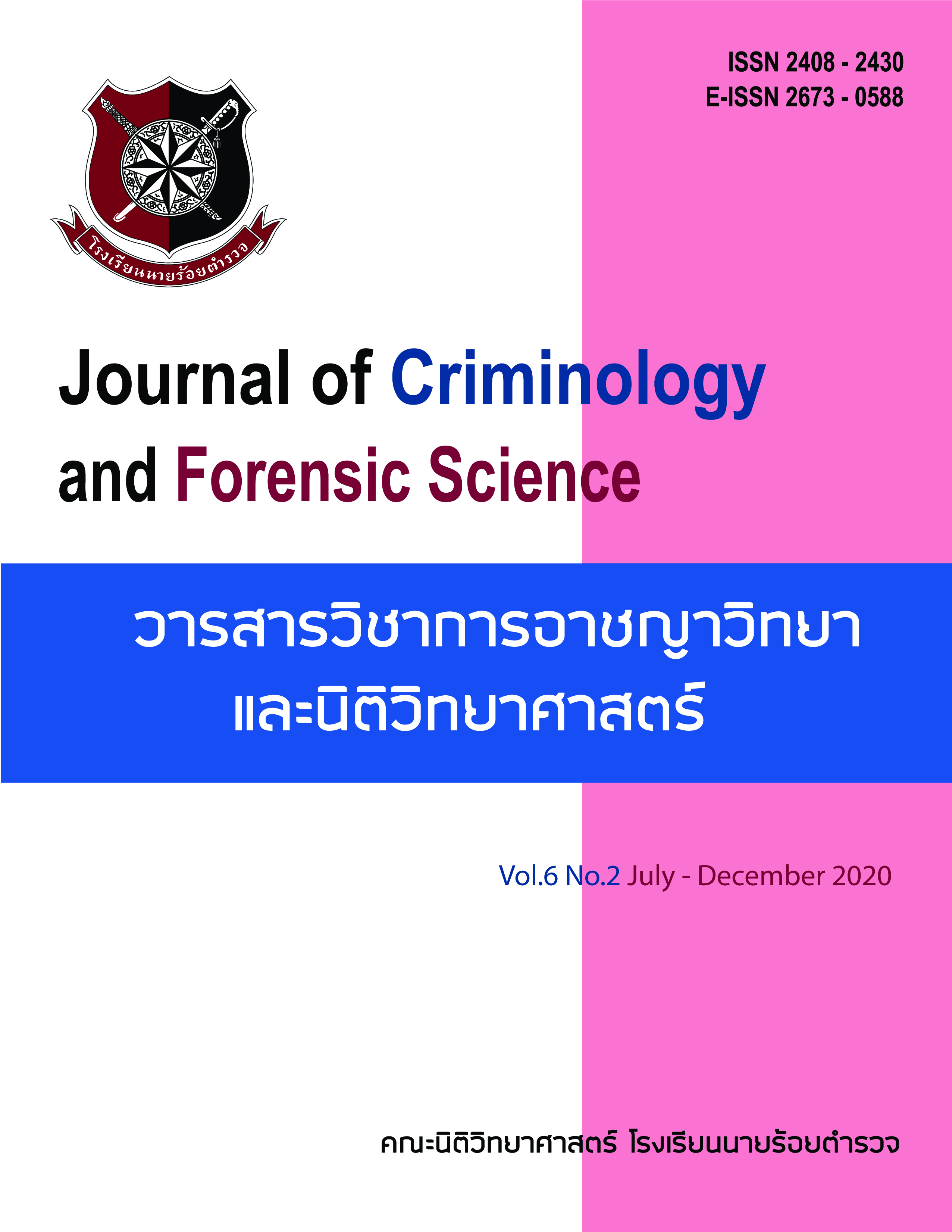แนวทางการนำไมโครไบโอมมาใช้ในงานด้านนิติวิทยาศาสตร์
Main Article Content
บทคัดย่อ
การศึกษาวิจัยครั้งนี้ มีวัตถุประสงค์เพื่อศึกษาวัตถุพยาน วิธีการตรวจไมโครไบโอมและนำเสนอแนวทางการนำไมโครไบโอมมาใช้ในงานด้านการวิเคราะห์วัตถุพยานทางนิติวิทยาศาสตร์ เป็นการวิจัยเชิงคุณภาพ โดยผู้วิจัยทำการถอดบทเรียน และวิเคราะห์งานวิจัยที่เกี่ยวข้องกับไมโครไบโอมของทั้งประเทศไทยและต่างประเทศ จำนวน 13 เรื่อง พบว่า ไมโครไบโอมสามารถนำมาใช้ในงานด้านนิติวิทยาศาสตร์ได้ 3 ประเด็น ได้แก่ 1) การระบุยืนยันตัวบุคคล 2) การระบุตำแหน่งพื้นที่ และ 3) การประมาณระยะเวลาการตาย การระบุยืนยันตัวบุคคล สามารถตรวจได้จากการดูสัดส่วนของชนิดแบคทีเรียที่พบบนวัตถุพยานและชนิดของแบคทีเรียที่เป็นเอกลักษณ์เฉพาะของบุคคล ในการระบุตำแหน่งพื้นที่ สามารถตรวจได้จากวัตถุพยานประเภทดินและน้ำลาย เนื่องจากดินแต่ละแห่งจะมีรูปแบบไมโครไบโอมที่แตกต่างกันในแต่ละภูมิภาค เช่นเดียวกันกับน้ำลายของกลุ่มประชากรในภูมิภาคต่างๆ ส่วนการประมาณระยะเวลาการตาย สามารถตรวจได้จากแบคทีเรียที่เจริญเติบโตในแต่ละช่วงเวลาหลังการตาย ส่วนวิธีการหาลำดับนิวคลีโอไทด์ที่เหมาะสมสำหรับการตรวจไมโครไบโอม คือเทคโนโลยี Next Generation Sequencing ซึ่งเป็นเทคนิคที่สามารถหาลำดับนิวคลีโอไทด์ของแบคทีเรียที่มีจำนวนมากได้อย่างรวดเร็ว ถูกต้อง แม่นยำ และมีราคาต้นทุนในการตรวจต่ำ สรุปได้ว่า ไมโครไบโอมมีศักยภาพในการระบุยืนยันตัวบุคคลและระบุตำแหน่งพื้นที่ของข้อมูลให้มีขอบเขตแคบลงได้ และสามารถนำมาใช้ในการประมาณระยะเวลาการตายของศพได้
Article Details
เนื้อหาและข้อมูลในบทความที่ลงตีพิมพ์ใน วารสารวิชาการอาชญาวิทยาและนิติวิทยาศาสตร์ โรงเรียนนายร้อยตำรวจ ถิอว่าเป็นข้อคิดเห็นและความรั้บผิดชอบของผู้เขียนบทความโดยตรงซึ่งกองบรรณาธิการวารสาร ไม่จำเป็นต้องเห็นด้วยหรือรับผิดชอบใดๆ
บทความ ข้อมูล เนื้อหา รูปภาพ ฯลฯ ที่ได้รับการตีพิมพ์ใน วารสารวิชาการอาชญาวิทยาและนิติวิทยาศาสตร์ ถือว่าเป็นลิขสิทธิ์ของวารสาร วารสารวิชาการอาชญาวิทยาและนิติวิทยาศาสตร์ หากบุคคลหรือหน่วยงานใดต้องการนำทั้งหมดหรือส่วนหนึ่งส่วนใดไปเผยแพร่ต่อหรือเพื่อกระทำการใดๆ จะต้องได้รับอนุญาตเป็นลายลักษณ์อักษรจาก วารสารวิชาการอาชญาวิทยาและนิติวิทยาศาสตร์ ก่อนเท่านั้น
เอกสารอ้างอิง
2. Chamsuwannawong, A. et. al. (2009). Forensic Science 2 for Crime Investigation. 6th ed. Bangkok: G.B.P Center. (In Thai)
3. Chun, L.P. et al. (2015). An initial investigation into the ecology of culturable aerobic postmortem bacteria. Science and Justice, 55(6), 394-401.
4. Clarke, T.H. et. al. (2017). Integrating the microbiome as a resource in the forensics toolkit. Forensic Science International: Genetics. 30, 141-147.
5. David, L.A. et. al. (2014), Host lifestyle affects human microbiota on daily timescales. Genome Biology. 15, 1-15.
6. Fierer, N. et. al. (2008). The influence of sex, handedness, and washing on the diversity of hand surface bacteria. Proceedings of the National Academy of Sciences. 105(46), 17994-17999.
7. Handke, J. et. al. (2017). Successive bacterial colonization of pork and its implications for forensic investigation. Forensic science international. 281, 1-8.
8. Hauther, K.A. et. al. (2015). Estimating time since death from postmortem human gut microbial communities. Journal of forensic sciences. 60(5), 1234-1240.
9. Hewitt, K.M. et. al. (2012). Office space bacterial abundance and diversity in three meterpolitan areas. PLOS ONE. 7(5), 1-7.
10. Huiprasert, L. (2019). Chapter 3 The duration of death and the change after death. Retrived 23 July 2019, From https://ifm.go.th/th/ifm-book/ifm-textbook/114-lesson3.html. (In Thai)
11. Iancu, L. et. al. (2015). Using bacterial and necrophagous insect dynamics for post-mortem interval estimation during cold season: Novel case study in Romania. Forensic science international. 254, 106-117.
12. Iancu, L., Junkins, E.N. & Purcarea, C. (2018). Characterization and microbial analysis of first recorded observation of Conicera similis Haliday (Diptera: Phoridae) in forensic decomposition study in Romania. Journal of Forensic and Legal Medicine. 58, 50-55.
13. Jing Li et. al. (2014). Comparative analysis of the human saliva microbiome from different climate zones: Alaska, Germany, and Africa. BMC Microbiology, 14(316), 1-13.
14. Jisun Park et. al. (2017). Microbial forensic analysis of human-associated bacteria inhibiting hand surface. Forensic Science International: Genetics Supplement Series. 6, e510-e512.
15. Lax, S. et. al. (2015). Forensic analysis of the microbiome of phones and shoes. Microbiome. 3(21), 1-8.
16. Metcalf, J.L. et. al. (2017). Microbiome tools for forensic science. Trends in Biotechnology. 35(9), 814-823.
17. Olakanye, A.O., Thompson, T. & Ralebitso, T.K. (2014). Changes to soil bacterial profiles as a result of Sus scrofa domesticus decomposition. Forensic Science International. 245, 101-106.
18. Polrob, S. (2018). Crime victims and innocent people in criminal cases. Retrived 11 December 2018, from law.stou.ac.th/dynfiles/Ex.41716-13.pdf. (In Thai)
19. Rerkamnauychoke, B. (2018). Recent Advances in Forensic Genetics. 1st ed. Bangkok: Beyond enterprise. (In Thai)
20. Sinloyma, P. (2019). An Introduction to Forensic Science. Retrived 20 August 2019, from https://ajarnpat.com/data/document_study_Pat.pdf. (In Thai)
21. Somboonna, N. et. al. (2017). Soil microbiome in the north-eastern part of Thailand. Unisearch journal. 4(1), 10-16.
22. So-Yeon Lee et. al. (2015). Microbial forensic analysis of bacterial fingerprint by sequence comparison of 16S rRNA gene. Journal of Forensic Research. 6(5), pp.1-4.
23. Sukpaluk, W., Sangsophonjit, S. and Jirajaroenrat, K. (2009). Study on bacteria diversity in chicken intestinal tract by molecular approach. Faculty of Agricultural Technology Thesis King Mongkut's Institute of Technology Ladkrabang, Bangkok. (In Thai)
24. Ukoskit, K., Raksuksombat, M. & Khanbo, S. (2015). Second and Third Generation Sequencing Technologies. Thai Science and Technology Journal. 23(4), 633-650. (In Thai)
25. Wilantho, A. et. al. (2012). Next generation sequencing (NGS) technologies and their applications in omics-research. Thai Journal of Genetics. 5(2), 104-129. (In Thai)
26. William, D.W. & Gibson, G. (2017). Individualization of pubic hair bacterial communities and the effects of storage time and temperature. Forensic Science International: Genetics, 26, 12-20.


